Mealybugs, scientifically termed Pseudococcidae, are tiny, soft-bodied insects that are a common enemy of indoor plants worldwide. Encased in a white, waxy substance that gives them a cottony appearance, they hide in the most secluded parts of plants, sucking the life out of them. In a study published in the Journal of Economic Entomology, mealybugs were reported as one of the top pests responsible for economic losses in the indoor plant industry. These small pests reproduce rapidly, with the female mealybug laying up to 600 eggs in her short lifetime, leading to quick and extensive infestations.
While their tiny size might make them seem inconsequential, the damage they wreak on indoor plants is substantial. They deplete the plant’s sap, leading to stunted growth, yellowing leaves, and even plant death in severe cases. As indoor plants grow in popularity for their aesthetic appeal and air-purifying qualities, the need to control and eliminate mealybugs has become more important than ever. This article offers an in-depth guide on identifying, treating, and preventing mealybug infestations on indoor plants.
What are Mealybugs?

Mealybugs are a species of pests that have established their nefarious presence in the realm of indoor plants. Distinguished by a white, powdery or cottony appearance, these creatures are small but mighty in the harm they inflict. Typically, they multiply rapidly, feeding on plant sap and wreaking havoc on the overall health of your indoor flora.
Often, mealybugs invade a range of common indoor plants, including jade plants, African violets, and orchids, leaving telltale signs of their destructive feeding habits. You may spot discolored leaves, stunted growth, or a general decline in plant vigor as they continue to feast on plant juices.
How Can I Identify a Mealybug Infestation on My Indoor Plants?
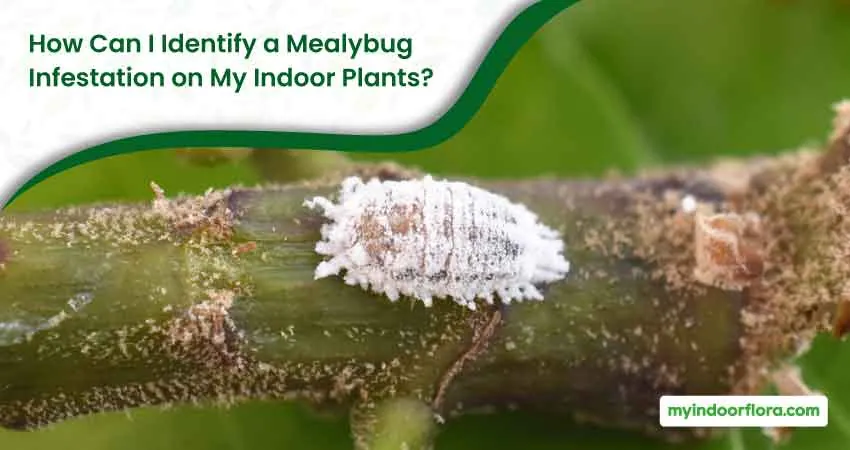
As a plant parent, your first line of defense against these pests is your keen eye. Identifying a mealybug infestation early can save your indoor plants from irreversible damage. The signs are unmistakable once you know what to look for.
The first telltale sign is the presence of small, fuzzy, white cotton-like masses on your plants. You may find these around the leaf nodes, underneath the leaves, or clustered on the stems. Additionally, a severely infested plant may show signs of poor health such as yellowing of leaves, leaf drop, or decreased growth rate.
What Do Mealybugs Look Like?
Mealybugs are small, soft-bodied insects that can be a serious pest for indoor plants. They typically have a few key characteristics that make them identifiable:
- Size and Color: Adult mealybugs are small — about 1/10 to 1/4 inch long. They are usually a pale pink or white color, often making them difficult to spot against the light-colored tissue of many plants.
- Waxy Coating: They are most recognizable for the white, powdery, waxy substance that covers their bodies, giving them a cottony or ‘mealy’ appearance — hence the name ‘mealybugs’. This coating provides them protection from moisture loss and from some forms of insecticides.
- Body Shape: Mealybugs have an oval-shaped body and are wingless. They move slowly, and often they may appear as if they are not moving at all.
- Long Tails: Female mealybugs often have two long tail filaments extending from their rear end, which can be mistaken for antennae.
- Egg Sac: If you spot a larger, cottony mass on your plant, it could be a female mealybug’s egg sac. These sacs can contain hundreds of eggs and are often found in plant crevices or under leaves.
Remember, early identification of mealybugs is crucial for preventing severe infestations and maintaining the health of your indoor plants.
Why are Mealybugs Attracted to Indoor Plants?
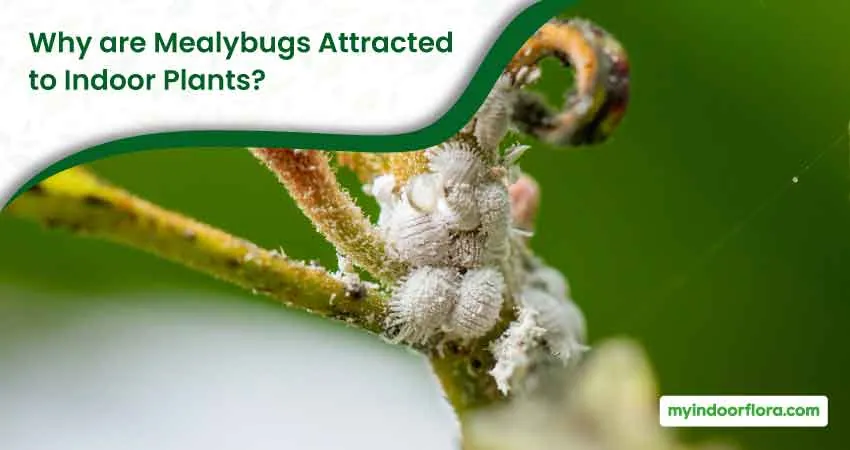
Mealybugs are attracted to indoor plants for several reasons. Predominantly, it’s the sheltered, stable environment that indoor plants provide. The absence of predators and the consistent temperature and humidity levels create an ideal breeding ground for these pests.
Moreover, certain types of plants seem to be favored by mealybugs, such as succulents, flowering plants, and foliage-rich species. These plants provide ample nutrition for the mealybugs and thus are at higher risk of infestation.
Where Do Mealybugs Come From?
Mealybugs can invade your home and infect your indoor plants through various sources:
- New Plants: One of the most common ways mealybugs find their way into your home is through new plants. Before introducing a new plant to your indoor garden, it’s crucial to inspect it thoroughly for signs of these pests.
- Plant-to-Plant Transfer: If one of your plants has mealybugs, it’s possible for them to transfer to other nearby plants, particularly if the plants’ leaves touch each other.
- Garden Tools and Pots: Mealybugs can also hitch a ride on garden tools, pots, or other plant materials. Therefore, it’s important to clean these items before using them with your plants.
- Open Windows and Doors: Although less common, mealybugs can occasionally come in from outside through open windows and doors.
- Potting Soil: In some cases, mealybugs can also live in the soil of the plant, feeding on the roots. This means they can also come with the potting soil that you buy.
Controlling mealybugs starts with prevention. Regularly inspect your plants, keep your gardening tools clean, and isolate new plants before introducing them to your existing indoor garden. When detected early, mealybug infestations can be more easily managed and eradicated.
How to Prevent Mealybugs from Infesting Indoor Plants?

Prevention, as always, is the best course of action. By maintaining the right plant care routines and creating less-than-favorable conditions for mealybugs, you can deter these pests from making your indoor plants their home. Here are some effective strategies:
- Regularly inspect your plants: Mealybugs can hitch a ride on new plants or even on your clothing. Regular inspection helps in early detection and containment of the infestation.
- Keep your plants healthy: A healthy plant is more resistant to pests. Ensure your plants receive the appropriate amount of light, water, and nutrients.
- Quarantine new plants: If you bring a new plant into your home, keep it isolated for a while. This allows time to check for any pests before they can spread to your other plants.
How Can I Get Rid of Mealybugs on Indoor Plants?
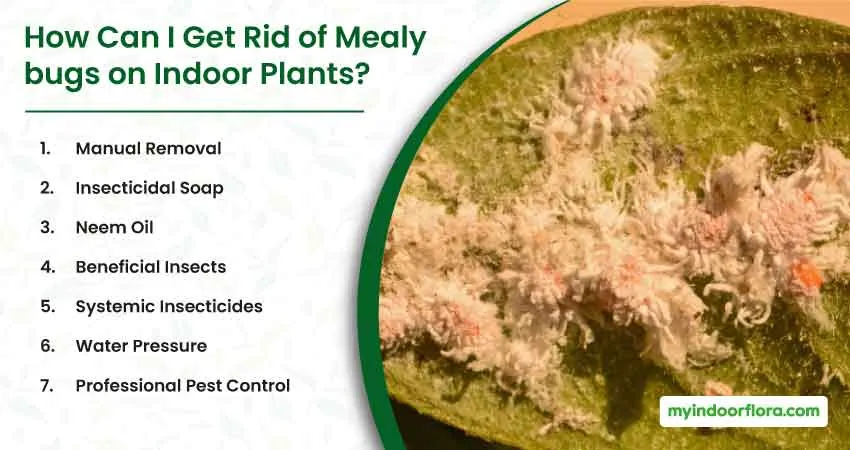
There are several strategies at your disposal to counter Mealybugs. I will explain 7 practical ways to banish mealybugs from your precious plants.
1. Manual Removal
When dealing with a small infestation, manual removal can be a practical and immediate solution. Armed with a cotton swab or a soft brush soaked in isopropyl alcohol, gently swipe the mealybugs off the plant. This alcohol disrupts their waxy exterior and effectively kills them. Repeat this process for a few days until you no longer see the pests.
Steps to follow:
- Dip a cotton swab or a soft brush in isopropyl alcohol.
- Gently brush or swipe off the mealybugs from the plant’s surface.
- Repeat this process for several days until there are no visible mealybugs.
- Regularly inspect the plant for potential reinfestations.
2. Insecticidal Soap
Available in most garden centers, insecticidal soaps are a go-to solution for many plant owners battling mealybugs. According to a study in the Journal of Economic Entomology, insecticidal soaps work by disrupting the insects’ cell membranes, leading to their death. Spray the soap solution thoroughly on the plant, paying particular attention to the undersides of leaves where mealybugs often hide.
Steps to follow:
- Purchase an insecticidal soap from your local garden center or online.
- Follow the instructions on the label to apply it to your plant. Generally, this involves spraying the solution onto the plant.
- Ensure you cover all areas of the plant, especially the underside of leaves.
- Repeat the application as directed on the product’s label.
3. Neem Oil
Neem oil is a natural insecticide that’s effective against mealybugs. It acts as a growth regulator, affecting the insects’ life cycle and reducing their ability to feed and reproduce. Mix neem oil with water and a little dish soap, then spray it on your plant.
Steps to follow:
- In a spray bottle, mix a few drops of neem oil with water and a squirt of dish soap. This helps the oil disperse in the water.
- Spray the mixture on all parts of the plant, ensuring to reach hidden mealybugs.
- Reapply every few days until the mealybugs are gone.
4. Beneficial Insects
Nature has its way of maintaining balance. Certain insects, like ladybugs, lacewings, and the Mealybug Destroyer (Cryptolaemus montrouzieri), are natural predators of mealybugs. These beneficial insects feed on mealybugs and help control their population. They can be purchased from specialized suppliers and released onto the affected plants.
Steps to follow:
- Purchase beneficial insects like ladybugs or lacewings from a reputable supplier.
- Release the insects onto the affected plants.
- Let nature take its course. The beneficial insects will feed on the mealybugs, reducing their population.
5. Systemic Insecticides
When the infestation is severe, systemic insecticides can be a reliable tool in your arsenal. These insecticides are absorbed by the plant and distributed throughout its system. When the mealybugs feed on the plant, they ingest the insecticide and die. However, they should be used judiciously, following the product instructions carefully, as they can have negative effects on beneficial insects.
Steps to follow:
- Select a systemic insecticide labeled for use against mealybugs.
- Follow the instructions on the product label for application. This generally involves applying the product to the soil or foliage.
- Regularly monitor your plant for any remaining mealybugs and reapply the insecticide as directed.
6. Water Pressure
Another non-chemical option is using water pressure to dislodge the mealybugs from your plants. A controlled stream of water from a hose can remove a significant portion of the mealybugs. However, this method should be used cautiously to avoid damaging sensitive plants.
Steps to follow:
- Using a garden hose or spray bottle, direct a stream of water at the mealybugs to dislodge them.
- Be careful not to damage the plant with high water pressure.
- Repeat as necessary until the mealybugs are eliminated.
7. Professional Pest Control
If the infestation persists despite your best efforts, it might be time to call in the professionals. Pest control services have access to a broader range of treatments and can provide expert guidance to prevent future infestations. Remember, an ounce of prevention is worth a pound of cure, and ongoing plant maintenance is key to keeping mealybugs at bay.
Mealybug Life Cycle And Effective Treatment Strategies
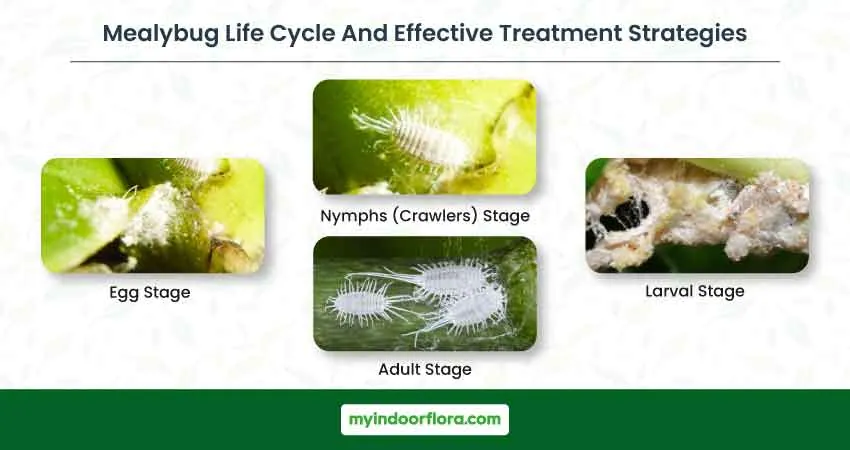
The life cycle of mealybugs offers valuable insights into how these pests propagate and what stages of life they are most vulnerable. Understanding their life cycle can aid in creating effective treatment strategies.
1. Egg Stage:
Female mealybugs lay their eggs in a fluffy, white wax material that acts as a protective casing. These egg sacs, often found in crevices or underneath leaves, can contain between 100 to 600 eggs per sac.
If you spot these sacs, remove them immediately to prevent the eggs from hatching. Regular inspection of your plants is crucial during this step.
2. Nymphs (Crawlers) Stage:
After 6 to 14 days, the eggs hatch into small, yellowish nymphs also known as crawlers. This is the most mobile stage of their life cycle, and they quickly disperse in search of feeding sites. Targeting this stage can help to contain the infestation.
Insecticidal soaps and oils are especially effective during this stage as they can directly reach the insects without the hindrance of a fully formed waxy coating.
3. Larval Stage:
The nymphs undergo several molts, each stage becoming larger and acquiring more of the characteristic waxy coating.
4. Adult Stage:
After several weeks to months (depending on the species and environmental conditions), the nymphs mature into adults. At this point, females begin producing eggs and the cycle starts anew.
Adult mealybugs are typically more resistant to treatment due to their waxy coating. However, they’re also less mobile than the crawlers, often staying put once they’ve found a suitable feeding site.
This makes adult mealybugs easier to target with spot treatments like isopropyl alcohol. A cotton swab dipped in alcohol can be used to wipe off and kill the adult bugs.
Unlike many insects, mealybugs don’t have a pupal or metamorphosis stage. Their transformation from crawler to adult is gradual, and they can feed on plant sap at every stage of their life, causing ongoing damage.
How To Prevent Mealybugs From Coming Back

Keeping mealybugs from returning once you’ve successfully eradicated them involves proactive and consistent care. Follow these guidelines to maintain a healthy, mealybug-free environment for your indoor plants:
1. Regular Inspection:
Check your plants regularly, at least once a week. Look for signs of infestation such as a cottony, waxy substance on the leaves, stems, or in the soil, or any changes in plant health like yellowing leaves or stunted growth.
2. Quarantine New Plants:
New plants can potentially harbor mealybugs. Keep new additions separate from your other plants for a few weeks and observe them for any signs of pests.
3. Maintain Plant Health:
Healthy plants are less likely to suffer severe mealybug infestations. Regular watering, appropriate light, and proper nutrition can strengthen your plants’ natural defenses.
4. Clean Your Tools:
Mealybugs can spread through contaminated gardening tools or pots. Always clean these items thoroughly before and after use.
5. Don’t Over-fertilize:
Excess nitrogen can lead to soft, lush growth, which is attractive to mealybugs and other pests. Follow recommended fertilization guidelines for each specific type of plant.
6. Use Pest-Resistant Plant Varieties:
Some plants are more resistant to pests than others. When possible, choose varieties that are less likely to attract mealybugs.
7. Practice Proper Spacing:
Mealybugs can easily move from one plant to another if they’re placed too close together. Providing adequate spacing between your plants can help prevent the spread of pests.
8. Use Beneficial Insects:
For outdoor plants, consider introducing beneficial insects like ladybugs or lacewings, which are natural predators of mealybugs.
Remember, the key to keeping mealybugs at bay is consistent and proactive plant care. By monitoring your plants regularly and taking swift action at the first sign of infestation, you can prevent mealybugs from becoming a recurring problem.
Mealybugs Vs. Scale
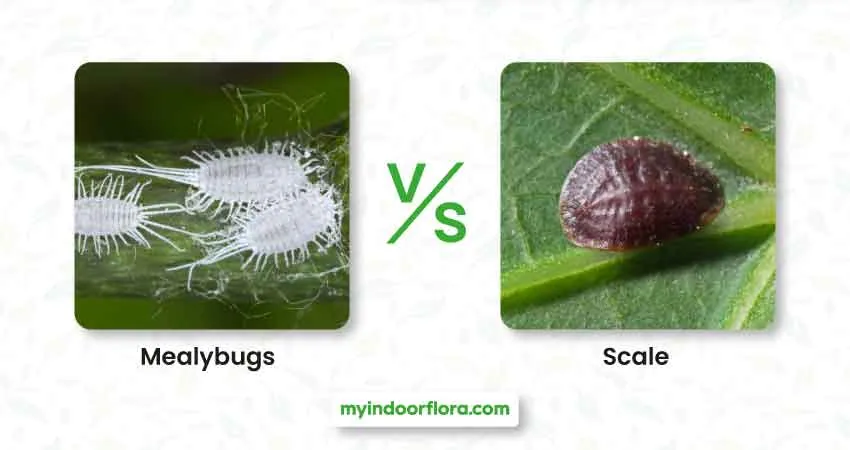
Mealybugs and scale insects are both common pests that can cause significant damage to your indoor and outdoor plants. Despite some similarities, there are distinct differences between the two in terms of their appearance, life cycle, and the specific damage they cause.
1. Appearance:
- Mealybugs: They are small, soft-bodied insects covered with a white, powdery wax. They get their name from this mealy, or flour-like, coating. Female mealybugs are wingless and usually oval in shape, while the less common males are smaller and have wings.
- Scale Insects: There are many types of scale insects, but they are generally characterized by a hard, protective shell that covers their bodies. The color, shape, and size of the shell can vary depending on the species. Some common colors include brown, tan, black, or red.
2. Life Cycle:
- Mealybugs: The life cycle of mealybugs includes an egg stage, a nymph stage (also known as crawlers), and an adult stage. The nymphs are highly mobile compared to the adults.
- Scale Insects: Scale insects also pass through an egg and crawler stage, but they then form a shell and become immobile. Once they attach themselves to a spot on the plant and form a shell, they don’t move.
3. Damage:
- Mealybugs: Mealybugs feed by sucking sap from the plant, which can lead to yellowing leaves, stunted growth, and leaf drop. They also excrete honeydew, a sticky substance that can lead to the growth of sooty mold.
- Scale Insects: Like mealybugs, scale insects feed on plant sap and excrete honeydew. Heavy infestations can cause yellowing of leaves, reduced plant vigor, and even plant death.
4. Control Measures:
- Mealybugs: They can be controlled by washing the plant with water, using insecticidal soaps, introducing natural predators, or using alcohol swabs for smaller infestations.
- Scale Insects: They can be challenging to control due to their protective shell. However, washing, horticultural oils, or insecticides can be effective. It’s also important to remove and dispose of any heavily infested plant material.
Both mealybugs and scale insects can be persistent pests. Quick identification and control are key to minimizing the damage they can cause to your plants.
Deciding When to Dispose of Mealybug Infested Plants
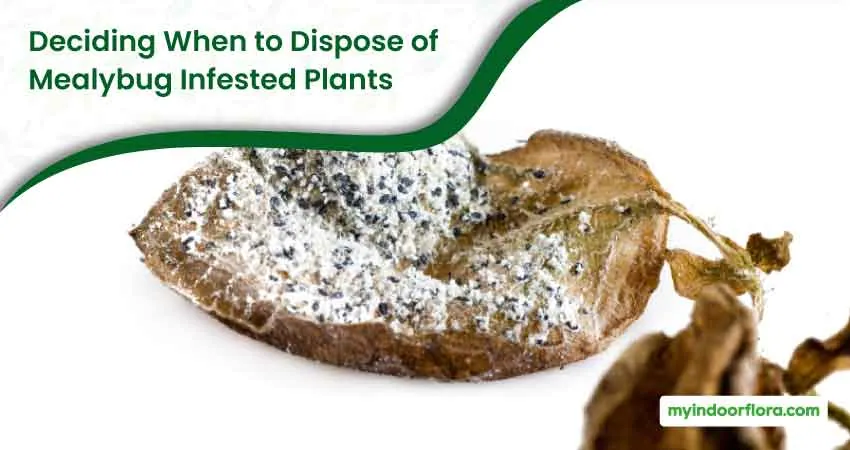
While treatment options can often salvage a plant facing a mealybug invasion, there are instances when it’s more appropriate, and even necessary, to dispose of the infested plant. The decision is influenced by a variety of factors including the severity of the infestation, the overall health of the plant, the risk of the infestation spreading, and the time and resources required to rescue the plant.
If the infestation is severe, covering all parts of the plant from the stems to the roots, it may be too late for recovery. Similarly, plants already under stress or exhibiting signs of poor health, such as yellowing leaves or stunted growth, may not survive even after the mealybugs are removed. The risk of the pests spreading to other plants should also be taken into account. Mealybugs can rapidly spread to nearby plants, thus sometimes it is better to discard one plant to save others.
The effort and cost of treatment versus the value of the plant is another deciding factor. For plants that are common or easily replaceable, disposal might be the most cost-effective option. Lastly, if you’ve tried multiple treatments with little success, it may be a sign that it’s time to let go of the plant. If you do decide to dispose of a plant, make sure to do so properly, ideally by sealing it in a plastic bag and disposing of it with your household waste. This will prevent the further spread of pests. In summary, making the tough decision to dispose of a plant depends on a variety of factors, and careful consideration should be taken to prevent further infestations.
